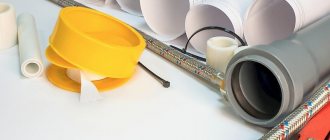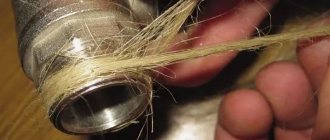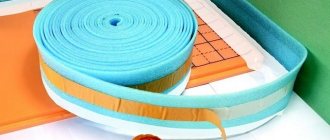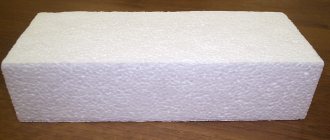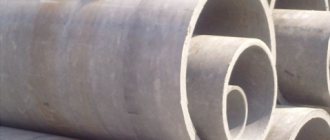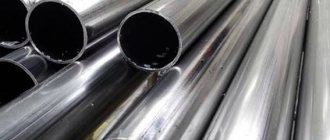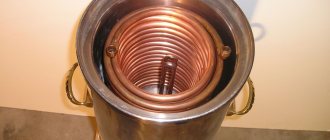When choosing FUM tape or flax strands for thread sealing, it is reasonable to consider the third option - modern and more convenient. However, if in practice the question has become tough - which is better, fum tape or tow - then the answer will depend on several factors: what thread is sealed, in what system, where, what is its feature. Let's talk today about the advantages and disadvantages of these classic sealants and analyze their scope of application.
Tow and plumbing - how it works
Plumbing flax, tow, flax strands are all names for the same thing. Tow flax is a sealant used for household needs for more than 50 years.
They compacted flax in the USSR, and they do it in the new Russia as well. Flax was not affected by any cataclysms: the transition to a market economy, the appearance of metal-plastic on the market, the demand for innovative sealants. Perhaps it will survive flax and renovation.
There is an opinion among ordinary people that the sealing of threads on flax is, if not last century, then definitely reeks of mothballs. There were cases when, upon seeing tow in the hands of a master, customers widened their eyes and advised not to do this again. They say there are better materials in stores.
However, professionals know that they need to work with any sealant, because the need for it may arise unexpectedly. Linen is a skein in the form of a braid, from which the required length is cut to seal a thread of a specific diameter. It is difficult to calculate the exact amount of flax to combine. They do this by eye, based on previous experience. We can say for sure that linen is suitable for carving in any condition: dirty, wet or old.
Those. For systems that have seen the world, for example, in old houses, flax is irreplaceable. Tow for pipes is also popular due to its low price. The cost of 100 grams of sanitary linen starts at 50 rubles and depends on the quality of the material. However, not everything is so simple. By itself, a strand of flax is useless.
You cannot simply wind flax and assemble the joint. Additional impregnation is required to enhance the sealing properties. Impregnation paste is applied on top of the flax wound on the thread and protects against corrosion, swelling, and rotting. Together with impregnation, the price of flax has already reached 150 rubles per 100 grams. The usual form of flax production - in braids - causes complaints from consumers.
Flax fibers get in the way, cling to clothes, stick to the impregnation and spoil the appearance of the joint. Some manufacturers today produce flax in a bobbin. A reel costs more than 200 rubles for 80-100 grams. Which, of course, reduces talk about the availability of flax to nothing.
The two main disadvantages of flax are its nature and application technology.
Flax is organic, plant material. And like plant material, it rots or decays over time. Impregnated tow lasts longer than the one without treatment, but still the compound on flax has a very specific and very short shelf life - 3-5 years. Such joints must be inspected regularly and checked for leaks. As for application, linen requires a trained hand and experience. First, the difficulty lies in the exact amount of linen tape.
Secondly, they wind it strictly along the thread, getting into each turn. Thirdly, the end of the strand is also secured in a special way at the beginning of the thread - so that when twisted it does not roll or slip. To secure the flax on the thread, notches are specially made or fittings with ready-made, factory-made notches are selected. It is not recommended to use flax on plastic, metal-plastic, or thin-walled threads.
In general, with a variety of sealants on the market, the use of flax raises a lot of questions. What can be used instead of tow? Synthetic sealants. They last longer and are less hassle. Let's look at an example of such a sealant - FUM tape.
Which is better linen or fum tape for water?
A professional plumber always has different types of seals on hand:
- fum tape;
- flax and sanitary paste;
- threads (type “Tangit”);
- anaerobic sealant.
The craftsmen know that all seals, when installed correctly, perform their task 100%. But to do this you need to know how to use it, what to use and under what circumstances. The abundance of modern sealing materials has displaced flax from its leading position. But not all masters agree with this.
The fact is that in past decades flax was used together with red lead or oil paint. Today – with Unipak plumbing sealing paste. Its main task is to prevent the flax from drying out and rotting. Connections made using these materials can be adjusted (axially shifted) by 45° without loss of tightness.
Benefits of flax:
- inexpensive price;
- suitable for sealing threads of any diameter;
- the connection will be good regardless of whether the base surface is wet or dirty.
The disadvantage is that any connection made with flax subsequently requires additional twisting and tightening. Another “minus” of flax is that it is not very convenient to work with: the fibers delaminate and cling to clothing and the tools and materials used.
If you compare flax and fum tape, the latter loses in that it does not allow you to adjust the connections without losing the tightness. That is, if you need to slightly turn an already tightened fitting, leaks may form in this place.
Alternative or not?
FUM tape is a synthetic sealant based on fluoroplastic.
As the name implies, it is a tape produced in a reel. The cost varies from 30 to 160 rubles and above and depends on the quality of the material, width and thickness. To seal the thread, the FUM is selected individually, depending on the diameter.
FUM tape, unlike flax, is most effective on plastic pipes and small threads. Many craftsmen note that they use FUM for diameters no larger than 1 inch, because...
otherwise, the tape consumption cannot be called economical. To apply FUM tape, it is first stretched into a thread, wound onto each thread several times, and then the entire width of the tape is applied to the thread and secured. They begin to assemble the connection and do it very carefully, so that the tape does not get lost or break. If you have never had to deal with this kind of sealant before, we advise you to practice “idle” - try the winding a couple of times, and then get to work. By the way, this way you will quickly understand whether to replace tow with tape or some other material. The moment of choosing tape is important.
If flax is judged by its appearance, then FUM should be tried. A high-quality tape stretches well and does not tear. But you can understand this by already purchasing the sealant - on site. In a store or market, it is unlikely that you will be allowed to test the product without paying. In addition to plastic and thin-walled threads, where else is fum tape relevant? For gas supply systems and non-standard liquid media For high-temperature systems For repairing rubber rings and gaskets in faucets, shower heads
FUM tape sealant
It is a specially designed seal made from a synthetic material – fluoroplastic. Moreover, for the convenience of the consumer, FUM tape is currently available in a wide range of sizes (width), which allows this type of sealant to be used for sealing pipes of any diameter.
Choosing a fumka
We should immediately note the advantages of the “fumka”
Firstly, the material stretches well and has a kind of tenacity, which is why it can be used without problems on threaded areas without notches (plastic, glossy, etc.), as well as on threads with fine pitches.
Secondly, even a non-professional can seal threaded connections using a hammer. Since the material penetrates well into all gaps, and the excess removes itself during joining (with a threaded connection).
Thirdly, using a synthetic sealant, you can seal not only water communications, but also air, gas, etc.
Fourthly, fum tape can very often be used as a winding material for sealing hoses (shower, watering, etc.).
However, all of the above advantages apply only to FUM tapes of appropriate quality. You can check the fumka immediately before purchasing - a good material should have sufficient elasticity, stretch and not tear.
Speaking about the compaction technique using a foam tool, it is important to highlight the following:
- First, the “fumka” is pulled into a thin thread and wound around the turns of the threaded section;
- Next, the entire width of the tape is wound over the thread (in this case, the material must be pulled tightly onto the workpiece) in several layers and wound along the thread.
- The tape is torn off and a threaded connection is made; if screwing occurs without effort, then the fuma is wound up further, thereby increasing the winding layer.
- In general, having completed 2 - 3 connections, you can understand how many layers need to be applied to the joint to ensure a high-quality connection and then proceed by analogy.
Winding direction of seal
Disadvantages of FUM tape
It is not advisable to use this sealant in hot water supply and heating systems (due to high and constantly changing temperatures).
Cannot be used on old or low-quality threads, due to the likelihood of mechanical damage during winding.
Not used in structures subject to vibration and shock loads.
It is not advisable to use for threaded connections with a diameter greater than 1 inch (due to the large winding layer).
Inability to adjust (correct) the connection at one time. If it is necessary to turn to the desired position, you must first remove the entire fuse and then rewind it.
What is important to know when buying tape?
Ineffective in heating systems because cannot withstand multidirectional loads and pressure changes Demanding on the quality of the thread - before winding, the thread is checked for the presence of burrs, notches, and roughness that can damage the tape
It is capricious and shows results only in the hands of a professional - to work with FUM tape, you need experience not only in application, but also in choosing a good material
FUM tape or tow? These sealants have a lot in common - low price, popularity in the market and in the professional environment, availability in any region.
But they also have serious disadvantages in common: not the most convenient application, limited scope of application, high consumption. If there is a large amount of work to be done - installation of communications in a private house, installation of equipment and plumbing - it is better to choose the latest generation of seals: polymer thread, anaerobic gel. With them you will do everything 3 times faster due to the high speed of application and instant sealing.
FUM tape and tow are traditional methods of sealing, which have long replaced modern sealants. They are easier to use and more reliable in sealing. You can purchase such seals on our website in the PRODUCTS section.
Thanks to the development of the construction industry and the appearance of the pipeline, people were able to use water and gas at home. However, there is a risk of emergency situations due to the leakage of these substances.
To prevent this from happening, it is necessary to create conditions under which the pipeline at the threaded connections will be as tight as possible.
A huge amount of materials are used for this purpose. Fum tape is one of them. Let's take a closer look at what it is and how to properly wind fum tape.
Scope of application of fum tape
Sealing tape made of fluoroplastic sealing material or FUM tape is a thin synthetic sealant that is available in the form of a translucent or white matte tape.
It has high mechanical and thermal resistance. This property of the material is due to the fluorine content in the composition. The tape does not age, does not break when subjected to tensile deformation, and is resistant to aggressive chemical environments and high temperatures.
Threaded, nipple and flange connections of process pipelines are sealed using fum tape. In addition, this material is successfully used in the supply of cold and hot water, as well as various engineering systems that operate under pressure, the value of which does not exceed 9.8 MPa.
Fum tape is made from fluoroplastic f4.
Bundles of this material are rolled out and wound into rolls, the width of which ranges from 10 to 16 mm. The composition of this product may be supplemented with lubricants. It depends on the brand of FUM.
Marking of fum tapes:
FUM 1. Used as a sealant for general industrial pipelines, as well as for systems that work with aggressive chemical media. The lubricant is 20% vaseline oil; FUM 2.
Designed for use in systems that operate with strong oxidizing agents. There is no lubricant in the composition; FUM 3. It is used in systems in contact with clean media.
What is FUM tape
FUM tape is an abbreviation, where FUM means fluoroplastic sealing material . It is made from fluoroplastic (round, square or rectangular cross-section) by rolling into a rope (FUM rope) to the required thickness, after rolling, it is cut to a measured width and formed into rolls. The roll width can be from 10 to 25 mm . Then, plumbing sealant of different widths and thicknesses is wound onto reels.
Used for installation of heating, water supply and gas supply systems. Serves as a deformable filler and thread lubricant, which significantly increases the sealing of threaded connections.
Advantages:
- Low cost .
- Speed and ease of installation .
- Ideal for small diameters.
- Keep your hands clean while working.
- Calmly tolerates contact with alkalis and acids .
- High operating temperature range .
- High elasticity .
- Long service life . More than 10 years.
- Unlimited shelf .
Flaws:
- The job requires skill. If wound incorrectly, there is a high probability of leakage.
- There is no possibility of adjustment (adjusting the angle of the fitting).
- Less effective on large diameters.
- Not suitable for heating.
- Does not withstand constant vibration and temperature changes .
Properties and technical parameters of fum tape
The main advantage of fum tape is that it has plasticity, high strength, non-toxicity, chemical and thermal resistance, and corrosion resistance. Also, the fum tape can be operated under high pressure conditions up to 41.2 MPa at an operating temperature from – 60° to + 200°C.
FUM is a highly flammable and non-explosive material. The temperature at which the tape can spontaneously ignite is +520°C. If FUM is heated at temperatures above +260°C, volatile fluoride toxic compounds begin to be released.
What to choose: fum tape or linen?
Before the advent of fum tape, flax, or tow in other words, was successfully used as a sealing material for threaded connections at home.
This material is produced from waste after flax processing. Basically, tow is used to seal threaded connections of metal pipes using silicone sealant. This method has been tested repeatedly by plumbers for many generations.
Many modern experts do not use flax, as they consider it an outdated material that has outlived its usefulness. This opinion can be explained by the fact that it is necessary to have certain skills when working with tow, and working with fum tape is easy and does not require any training.
When laying flax on a threaded connection, separate the tow fibers and carefully wind it so that the inter-threaded grooves are filled. The formation of overlaps through the turns should not be allowed. The next step is to apply and smooth with a brush a layer of sealant over the tow.
- An insufficient amount of sealant can lead to a decrease in the tightness of the connection. If there is an excess of material, it is cut off by the pipes at the moment of tightening, which causes the creation of excess stress. As a result, deformation failure of parts may develop during installation or operation. Therefore, it is necessary to take the amount of material used seriously.
According to the information described above, it is advisable to use fum tape for sealing metal-plastic and plastic pipes. It is better to use tow when working with old metal pipes. Fum tape in this case will be useless and will not be able to provide sufficient tightness.
FUM tape for gas
This type of product is yellow in color, made from 4D fluoroplastic and provides reliable fixation of threaded connections of gas pipes, preventing possible leaks. The width can be made in the range of 15–20 mm.
It is worth remembering that the method of sealing connections using this material is justified only if tightness can be achieved only by sealing the threads. In cases with sealing connections of rubber or bellows hoses, special paronite gaskets are used.
Reference! FUM tape wound “for reliability” around the connections of flexible metal or rubber hoses can prevent the gasket from sealing the joints, which will cause a leak.
How to wind fum tape correctly?
To ensure the tightness of threaded connections, it is not necessary to have certain skills. In this case, you should know some of the nuances and features of this operation.
When replacing or repairing various plumbing connections with your own hands, before you start winding the fum tape, you need to clean the old threaded connection from debris and, accordingly, rust. Then it is recommended to wipe all parts of the pipeline with clean gasoline or solvent and wait until completely dry.
The fum tape is wound onto the external thread in a clockwise direction. The tape must be slightly tensioned to ensure sufficient winding density.
A well-tensioned tape makes the connection high-quality and fairly airtight. In this case, you should monitor the tension force so as not to provoke rupture of the material. The end of the fum tape must be brought out so that it does not become an obstacle to screwing on the connecting element.
The sealing material should be wound in several layers to sufficiently seal the joint.
The number of layers depends on the diameter of the pipe used. To seal pipeline connections with a diameter of 15 to 25 mm, three layers of sealant are sufficient. If the diameter of the pipes varies from 25 to 40 mm, four layers are wound.
Material selection
Fum tape is a sealing material made from fluoroplastic fiber of translucent or white color. It allows you to reliably seal nipple, threaded or flange type connections with internal pressure from 9.6 to 9.8 MPa.
There are several types of this material, which have their own characteristics. Usually the appropriate one is chosen from among them:
- FUM-1 is a tape material, which is additionally supplied with vaseline oil lubricant. It is used for sealing in water supply and gas pipeline systems. It is possible to use it in those communications where there is an aggressive influence, for example, acidic or alkaline. The width of the product ranges from 10 to 100 mm, thickness from 0.1 to 3 mm.
- FUM-2 is a belt manufactured without additional lubrication. Most often it is used in plumbing systems that contain large amounts of oxygen or oxidizing substances. The width of the tape ranges from 3 to 20 mm, thickness from 0.045 to 0.4 mm.
- FUM-3. This type of tape is much less common and is not used independently. It represents edge trimmings of the two types mentioned earlier. Width varies from 3 to 20 mm, thickness - from 0.12 mm.
The main difference between the sealant is the width of the tape
For those who have never encountered such tapes, it is difficult to choose a suitable option. Most often, inexperienced craftsmen are interested in which tape to choose for working with household water supply, for example, for installing a washing machine faucet.
For use in small threaded connections in contact with water, it is recommended to use fum tape with a width of 12 mm and a small thickness of up to 0.1 mm. For larger threads, a tape with a width of 19 mm and a thickness of 0.12 to 0.2 mm would be an excellent solution.
It is best to use only those films that stretch well. Otherwise, the material will quickly begin to crack during operation.
In general, if any alternative work is carried out, the material and its dimensions are selected depending on their type. Consultants in construction stores will always help you make your choice.
The process of winding sealing tape onto a thread
On a note!
Fum tape has a number of properties that must be taken into account when working with it.
- This material is quite slippery and can cause inconvenience. Once the tape has been wound onto a threaded connection, it can no longer be unwound in the opposite direction without breaking the seal. If it becomes necessary to loosen a connection that was sealed with fum tape, this cannot be done without compromising the integrity of the wound material, and the tape will be needed again to seal the joint again.
- Date: 09/24/2015 Rating: 40
Sometimes, during home renovation work involving sealing at the points of contact of the threads, it is necessary to ensure the maximum tightness of the parts. An example of such work would be a routine replacement of a water tap. Tow or FUM tape?
Which choice would make the most sense? Of course, due to an old habit, a large number of people still prefer flax. This material is inexpensive and safe to use.
Thread sealing: a - tow, b - mastic, c - FUM sealing tape.
Civilization is developing at a rapid pace. The FUM tape used in practice is used as often as the old, familiar version. Its use is increasingly gaining leading positions among Russian specialists.
Cold and hot water
BUT wait, why use tape or thread then? Why were they created at all? It's simple - they are perfect for waterways. Where there is a constant temperature.
For example, for cold water . Where there is no thermal expansion and then cooling, there are no high temperatures. It seals just fine.
For hot water you need to think about it . It is clear that the pipes are almost always heated; they are hot in one position. No one will turn them down, the temperature is also constant - THIS IS A PLUS. BUT, the water may be turned off for a while, for example, during seasonal testing, then the pipes may also cool down and leaks may appear at the joints. Also, over time, FUM seals can dry out, as happened to me.
Now we are watching a useful video.
EVENTUALLY. Where there are no high temperatures, no expansion of metals, FUM can and even should be used, it’s an excellent means. For heating and hot water, I would advise you to use Paklya with sealing paste, it has been working for decades.
This is where I end, I think my materials were useful to you. Read our construction site.
Sometimes, during home renovation work involving sealing at the points of contact of the threads, it is necessary to ensure the maximum tightness of the parts. An example of such work would be a routine replacement of a water tap. Tow or FUM tape? Which choice would make the most sense? Of course, due to an old habit, a large number of people still prefer flax. This material is inexpensive and safe to use.
Thread sealing: a - tow, b - mastic, c - FUM sealing tape.
Civilization is developing at a rapid pace. The FUM tape used in practice is used as often as the old, familiar version. Its use is increasingly gaining leading positions among Russian specialists.
Flax fiber: characteristics
High-quality tow should be without shreds or tears, and have the appearance of a braid.
No one will remove tow from store shelves, because this type of fabric is not capricious, but it is not entirely easy to work with. After all, a situation often arises in which it is not easy to unwind a thread with flax fiber wound on it, and sometimes such ideas remain unrealized.
And in the Soviet era, such connections were additionally treated with enamel (red lead), then tightly twisted. Once the paint dried, the joint bonded perfectly. This method was distinguished by its strength and reliability.
As soon as silicone-based sealants appeared on Russian markets, flax compounds were forgotten. Although many experts consider the latter type of material to be a thing of the past, it does not leave its position even today.
Despite the certain complexity of working with tow, its installation is carried out through the following steps. First, the tow is distributed among the fibers, then they are placed in the grooves between the threads.
There should be no kinks through the coils. Then you need to apply sealant. When screwing in flax fiber, remember that there should not be an excess of this fabric. After all, with further operation of the connection, excessive stress appears, as a result of which parts can break.
Return to contents
This raw material is an artificial material with a fluoroplastic base. It is distinguished by noticeable stability regarding the effects of temperature and the influence of mechanical stimuli. It is used in many areas, as its ability to withstand chemical components and hot substrates is maximum.
The main advantages of FUM tape: non-toxic, non-rotting, plastic, resistant to oils and gasoline.
FUM tape is very strong, it is incapable of breaking, does not rot or smolder, does not emit toxic fumes, and is not subject to corrosion.
Material of this kind can be used even under the most severe conditions. This electrical tape does not burn or explode. However, at very high temperatures, over 260 degrees, it can release toxins.
To ensure stable winding of the connection, you should move in a clockwise direction.
In this case, the thread will sit tightly in place, the connection will not move from side to side. The quality of the registration depends on the thread tension. To determine the number of layers required, it is necessary to monitor the diameter of the pipes and the features of the thread.
Return to contents
The tow, separated by fiber, without allowing any kinks, is placed in the grooves between the threads, and a sealant is applied.
The use of new materials is dictated by the needs of our time. We will try to clarify many questions regarding materials for threaded connections. After all, not all people are professionals in the construction field, and a large number of craftsmen need to gain the necessary knowledge.
To determine the choice of the necessary raw materials for a threaded connection, you should find out how the thread was made.
To obtain high-quality carvings, several methods are used.
One of them is based on blade plan processing, which results in a very sharp application. Extreme caution should be used with this option, otherwise you can easily get hurt. It is performed by using a variety of cutters, friezes, and marks.
Another method is roller grinding, forming threads with special taps and dies.
The most common method is slicing.
Diagram of thread cutting using dies.
This design is easy to use and allows even an inexperienced craftsman to complete the job with a minimum number of accessories. There is no need to select pipes or rods by size. Thread cutting in industrial production conditions is unprofitable; the productivity level of such structures is noticeably reduced, and there is also the possibility of a significant amount of waste in the form of metal shavings.
Threads produced by rolling are characterized by high quality and good performance. But at the same time, careful calibration of the metal should be done. This method is most often used in industrial settings.
A pipe made by cutting requires a sealing layer of flax, because it helps fill the gaps between the threads and serves as an excellent sealant. If minor leaks occur at the initial stage, it quickly disappears as the tow swells from moisture. Thus, the linen covers all possible cracks and holes.
Return to contents
Now the tow kit comes with a special lubricant that helps the threads tighten easily.
This connection does not rust for a long time; after the end of its service life, the structure is simply disassembled. Tow made of flax is an essential attribute during repairs in order to seal old-format threads; it is even suitable for winding on a rusty pipe. In such cases, flax becomes an indispensable assistant.
FUM tape used to compress metalwork using the cutting method may cause leakage. And a very sharp thread will cut through it.
There will not be the required degree of compression. Naturally, good results can be achieved. To do this you need the FUM tape itself, patience and perseverance.
This type of material used for knurling joints will be very acceptable. After all, the originality of the pattern on the pipe is achieved through rollers; the method of cold plastic deformation is used.
The resulting thread takes on a trapezoidal configuration. FUM tape is not afraid of such bases; they will be safer for the hands of the master. The sealing material, and the nerves, will be in perfect order.
Naturally, choosing the right carving method will be difficult for people who do not have experience working with such a base. Almost all designs on metal pipes are made by cutting, but there are exceptions. Metalworking of almost all plumbing equipment intended for household use: valves, water taps, fittings was carried out using the knurling method.
To ensure that the operation of FUM tape and tow does not present surprises, you should follow some recommendations. Thus, winding an excessively large layer of flax leads to the removal of the part from its working condition due to an increase in temperature. To prevent such moments, the outer base of the thread should be marked with notches.
The tow will not slip off.
The quality of this fabric also plays an important role; fabrics with lumps should be excluded. High-quality material resembles the appearance of a braid. The FUM tape is tightly wound onto the thread and pressed with your fingers to ensure a tight fit.
When choosing between tow and FUM tape, it can be very difficult to decide which material is better. To optimize the choice, factors influencing the choice of sealant should be taken into account.
Installation of any pipeline involves the use of a sealant.
To make threaded, flanged and nipple connections airtight, along with traditional tow, modern material is used - a universal fluorine-containing film. Fum tape, fumka, plumbing tape, Teflon are the main names of thread sealant. Let's look at the technical characteristics, pros and cons of the material, and compare it with flax tow.
Modern compaction has replaced tow, but has not supplanted it
Modern compaction has replaced tow, but has not supplanted it
FUM tape: some features
This raw material is an artificial material with a fluoroplastic base. It is distinguished by noticeable stability regarding the effects of temperature and the influence of mechanical stimuli. It is used in many areas, as its ability to withstand chemical components and hot substrates is maximum.
The main advantages of FUM tape: non-toxic, non-rotting, plastic, resistant to oils and gasoline.
FUM tape is very strong, it is incapable of breaking, does not rot or smolder, does not emit toxic fumes, and is not subject to corrosion.
Material of this kind can be used even under the most severe conditions. This electrical tape does not burn or explode. However, at very high temperatures, over 260 degrees, it can release toxins.
To ensure stable winding of the connection, you should move in a clockwise direction. In this case, the thread will sit tightly in place, the connection will not move from side to side. The quality of the registration depends on the thread tension. To determine the number of layers required, it is necessary to monitor the diameter of the pipes and the features of the thread.
Plumbing tape: production and types ↑
PTFE sealing material, or fum tape for short, is a polytetrafluoroethylene film used to seal pipe joints. It is made by rolling out a fluoroplastic rope to the required thickness.
The sealant is produced in the form of a tape of a certain size, wound on a reel (similar to electrical tape). Used when installing systems under pressure: water supply, gas supply, central heating. The material functions as a deformable filler and at the same time as a thread lubricant, which improves the sealing of connections.
Types of fum tape:
- fum-1 – designed for sealing pipelines working with aggressive media. Contains lubricant - purified vaseline oil; fum-2 - used in systems in contact with strong oxidizing agents, therefore not impregnated with lubricant; fum-3 - used in systems working with clean media. Does not contain lubricant.
Plumbing tape fum also varies in size: thickness ranges from 0.075 to 0.25 mm; width starts from 10 mm; length from 1000 mm.
They produce a special yellow gas fum tape with a thickness of 0.15-0.25 mm. For gas pipes operating under low pressure, the use of ordinary plumbing tape is allowed.
Special gas fum tape is denser than conventional plumbing tape
Fum tape: application, advantages and disadvantages
The raw material for the manufacture of synthetic waterproofing tapes is fluoroplastic-4. The thickness of the strip ranges from 0.1 to 0.14 mm, and the width can be from 10 mm to 60 mm. Fum tapes are impervious to moisture. They can operate in a temperature range from -60 to +4000C.
Important!
The material can withstand temperatures of more than +4000C, however, it should be taken into account that already at +2600C synthetic polymers begin to release fluorine compounds that are dangerous to human health.
Fum tape has become widespread thanks to:
- Ease of installation;
- Elasticity and high tensile strength;
- Long service life;
- Possibility of quick dismantling;
- Possibility of use for sealing plastic and metal-plastic pipes, as well as thin-walled fittings.
In addition, when sealing with fum tape, no additional treatment of the winding with mastic or impregnation is required.
The disadvantages of fluoroplastic seals are as follows:
- The material is not advisable to use for diameters greater than 50 mm due to the insignificant thickness of the tape (0.1 - 0.14 mm);
- With amplitude temperature fluctuations, the tightness of the connection may be broken;
- Sharp edges easily cut through the fumig tape, disrupting the uniformity and solidity of the seal;
Important!
When using synthetic materials, even a slight rotation of the installed fittings can lead to loss of tightness. If the connection is disassembled, the thread must be thoroughly cleaned of tape residues and the winding must be repeated.
Technical characteristics and properties of fum tape ↑
Main properties of PTFE:
Low coefficient of friction. Fluorinated plastic polymers (PTFE) have a very low coefficient of friction - they are slippery, which makes it easier to connect fittings. They act as a kind of gasket for pipe threads, improving fit and sealing. Heat resistance.
PTFE has an extremely high melting point for a plastic - 327 degrees. They are designed for use at temperatures up to 260 degrees (when heated above, they release toxic fluoride compounds). PTFE is an excellent dielectric (electrical insulator), which is an additional advantage. Plasticity and strength.
Resistant to mechanical stress. They operate at a constant pressure of up to 10 MPa and withstand differences of up to 41 MPa. Average service life is 13 years.
Prolonged exposure to light slightly deteriorates the properties. Chemical and biological inertness. They are highly resistant to acids and alkalis. There is no solvent for PTFE yet.
The polymers are uniformly coated with fluorine atoms, which makes the material inert to almost all chemicals. Decomposition is possible only under extreme conditions created in special laboratories. Not subject to rotting.
The ductility of PTFE allows the plumbing tape to stretch and fit tightly around the threads
Tow: what is it and how to work with it ↑
Before fum tape appeared on the market, plumbing tow, which was flax fibers, was used to seal threaded connections of pipes. Optimal results were achieved by coating the layer of tow wound on the thread with a small amount of oil paint. Such a connection was difficult to disassemble after several years.
Now sanitary linen in the form of long silky threads is used along with new sealing materials. Only now a layer of sealing paste is applied on top of the winding, ensuring a reliable and durable connection. The paste protects the flax from rotting and makes dismantling easier if necessary.
Flax fibers are long, thin, strong, fit tightly into the grooves of the thread and do not deform when screwed
How to wind tow on a thread ↑
To prevent the flax from sliding along the thread, there are notches on it.
Please note: if there are no factory notches, they must be applied yourself, otherwise when screwing on the fitting, the flax will run off the thread.
Impregnation of flax with a special paste, coupled with proper winding, guarantees that the connection will last a long time
For winding, a small strand of flax is separated. The length and thickness of the “strand” are determined visually depending on the diameter of the pipe.
The winding is done as tightly as possible, the threads are directed along the thread, the free end of the tow is fixed with a finger, and after a couple of turns it is brought into the guide strand. The tightness of the connection is ensured by the optimal layer thickness. It is quite difficult to calculate the density: you need experience and a certain “plumbing” eye.
How to properly wind fum tape onto a thread ↑
The tape is wound around the external thread of the fitting. When repairing plumbing, the old connection must be cleaned of rust and dirt, and then the surface must be degreased with a solvent. Winding is done only after drying.
The main requirement: the fum tape should be pulled quite tightly so that it fills the grooves and fits the thread tightly. Experienced plumbers say that it is better for the tape to break than for loose winding. The number of layers varies from 4–6 to 20–25 and depends on the thickness, width of the tape and pipe diameter - the main thing is that all the threads are hidden.
Plumbing tape requires a little more than tow, since, unlike flax, it will shrink. When working with fittings with a diameter of 1 inch or more, it is more convenient to wind the fuse over the entire width, making sure that it is pressed into the coils. After screwing the nut, the fibers of the fum tape are torn into threads that fill the interturn space - the seal remains in the thread and seals it.
Important: adjustment (adjustment) without loss of tightness is impossible - you cannot even slightly unscrew a twisted fitting.
Fum tape is quite elastic, so when wound tightly, the thread turns are clearly visible
Which is better: tow or fum tape ↑
Each material has its own advantages and disadvantages. Plumbing flax is used to seal joints of steel pipes (especially rusty and/or large diameter ones).
Advantages of tow:
- the possibility of adjusting the connection: unscrewing back by 45 degrees is permissible; reliable tightness: absorbs moisture well; resistance to mechanical stress; easy dismantling of the connection.
The disadvantage is the tendency to rot/decompose, since tow is a natural material.
It is preferable to use plumbing tape on small-diameter pipes, plastic pipes, and in the case of thin-walled fittings. It is easier to work with fum tape and takes less time to install.
There is no clear answer to the question: “Which is better – fum tape or sanitary linen?” It all depends on the specific plumbing job. For example, it is more convenient to connect a kitchen faucet with a flexible hose using fum tape, and it is better to seal a fitting on a water pipe using tow.
A better seal is achieved by winding a small amount of flax and then securing it with several turns of tape.
Anaerobic gel sealants: sanitary gel ↑
Another modern material for sealing pipe threads is sanitary gel. Reliable compaction occurs due to the polymer component of the gel. After hardening, sanitary gel does not shrink or expand, is resistant to temperature changes (from -60 to +150) and pressure surges, and has proven itself in various environments: water, natural and liquefied gas, heating antifreeze.
How to seal a plumbing connection: flax, fum tape, anaerobic sealant - a specialist decides
Sanitary gel is produced in three types:
- In green tubes - easy dismantling. In blue tubes - medium dismantling. In red tubes (Stop Master Gel) - heated dismantling.
Installation using sanitary gel is simple: shake the tube and apply the gel in a thick layer around the entire circumference of the thread, distribute it evenly (with a brush, a special spatula), and assemble the structure. Excess gel is removed with a rag. Polymerization of the gel occurs in 15–20 minutes.
Important: Sanitary gel should only be applied to a clean, grease-free surface.
